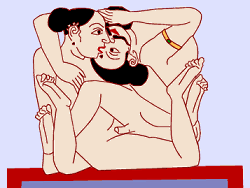|
|

|
|
The art of lovemaking
In some civilizations and historical periods, women and men cultivated elaborate sexual techniques that required long practice and went well beyond the purpose of reproduction. Instead, the couple strove to achieve a higher degree of physical and spiritual health.
(After an Indian painting, 18th century A.D.)
|
|
|
Today, scientists argue whether, even in "simple" cases, the concept of drive really explains very much. However, be that as it may, we can easily see that, at least in the case of sex, this concept makes little sense. First of all, sexual activity is not necessary for the survival of any organism. A lack of food or liquid will lead to death, but a lack of sex has never killed anyone. Secondly, the strength of sexual desire does not depend on the degree of sexual deprivation. Sexual abstinence does not always increase sexual desire, and frequent sexual activity does not always diminish it. On the contrary, some people who have been abstinent for a long time eventually lose all interest in sex, while others who are extremely active continue to be easily aroused. Furthermore, people usually do not make themselves deliberately hungry or thirsty, but they often actively seek sexual arousal. Also, unlike hunger or thirst, this arousal may be caused and increased by psychological factors alone. Finally, hunger and thirst are experienced as unpleasant, while sexual arousal feels good and is thus rewarding in itself even if it remains "unsatisfied."
|